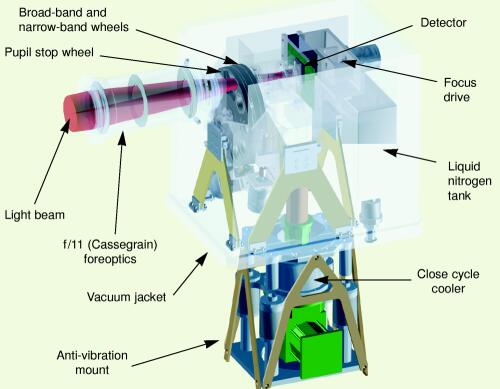Instrument Overview
- INGRID - A near-infrared imager
- INGRID and the Adaptive Optics Suite
- Applying to use INGRID
- Recent Developments
INGRID - A near-infrared imager
INGRID forms an integral part of the ING's adaptive optics suite
NAOMI. Since early 2004 it has been
permanently attached to one of NAOMI's two science ports
in the environmentally controlled enclosure
GRACE
at the
WHT's Nasmyth
focus. The
1024x1024
HgCdTe Hawaii detector array has a pixel scale of 0.04"/pixel, with
a
resulting field of view of approximately 40" x 40", and a wavelength
range from 0.8 to 2.5 µm. More information on the detector can be
found
here. INGRID's two filter wheels
contain a range of broad and narrow band
filters
and a further wheel holds a selection of
pupil stops.
The diagram below shows a 3D transparent model of INGRID, with the
light beam from the telescope focusing on the infrared detector.

Picture
credit: Paul
Jolley (ING)
INGRID was mostly built and developed at the ING and was commissioned
in March 2000. It was originally deployed at both the Cassegrain and
Nasmyth focal stations to provide (i) a wide field imaging capability
over a ~4´x4´ field of view and (ii) a high resolution
imaging mode over a ~40"x40" field of view (with the AO system NAOMI).
However, following the
successful commissioning of
LIRIS
in 2003/2004, INGRID's wide field functionality at Cassegrain has been
replaced by
LIRIS's imaging mode, meaning that INGRID is now one of two dedicated
science instruments for NAOMI. In early 2004, INGRID underwent a
major reengineering program to improve its mechanism control system,
thus enhancing both the reliability and accuracy of its filter and
pupil wheels.
INGRID and the Adaptive Optics Suite
INGRID is mounted on the adaptive optics bench in the GRACE enclosure.
The light path from the telescope always passes through the adaptive
optics system before reaching INGRID. Two keys optical elements in
the light path are (a) a tip tilt mirror and (b) a 76 element segmented
deformable mirror (DM). INGRID can be operated with NAOMI in
three
modes:
- Full AO correction - In
this mode, the deformable mirror is used
to perform high order corrections and the tip tilt mirror removes
low order image motion.
- No AO correction - In
this mode, both the deformable mirror and
the tip tilt mirror are "frozen". This mode eliminates all (or most) of
the
restrictions imposed when performing AO corrections with natural guide
stars. For IR imaging without AO correction we would normally recommend
the use of LIRIS, however this mode
of operation of INGRID will be useful for "target of opportunity"
observations.
- Tip tilt correction - In
this configuration, the deformable mirror
is "frozen" and the tip tilt mirror is used to perform a low order
correction. Although there will be a smaller improvement in image
quality than if the full AO correction is used, this mode has the
advantage that it can be used with (a) fainter guide stars and (b) with
guide stars at larger
separations from the science targets, both of which greatly
increase the sky coverage that can be observed.
The next section gives an overview of how to apply for INGRID
observations.
INGRID can also
be used with the ING's AO coronograph
OSCA
- more details on the specific preparation needed for OSCA observations
can be found
here.

